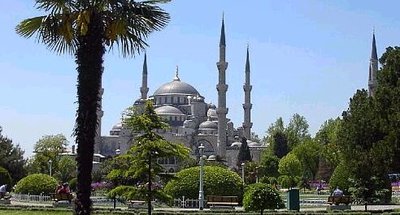Sultan Ahmed Mosque
|
|
The Sultan Ahmed Mosque (in Turkish Sultanahmet Camii, in English commonly called the Blue Mosque) is a mosque in Istanbul, the largest city in Turkey and the capital of the Ottoman Empire from 1453 to 1923. It is regarded as one of the greatest masterpieces of Islamic architecture.
The mosque was built between 1609 and 1616 by order of the Sultan Ahmed I, after whom it is named. He is buried in the mosque's precincts. It is located in the oldest part of Istanbul, in what was before 1453 the centre of Constantinople, the capital of the Byzantine Empire. It is next to the site of the ancient Hippodrome of Constantinople, and a short distance from the great Christian Church of the Holy Wisdom (Hagia Sophia).
It is within walking distance of the Topkapi Palace, residence of the Ottoman Sultans until 1853 and only a short distance from the shore of the Bosphorus. Seen from the sea, its domes and minarets dominate the skyline of the old part of the city, as was its builders' intention.
The mosque was deliberately sited to face Hagia Sophia, to demonstrate that Ottoman and Islamic architects and builders could rival anything their Christian predecessors had created. The two buildings thus comprise a unique historical and architectural precinct.
Today Hagia Sophia is a museum, but the Mosque of Sultan Ahmed is still a place of Islamic worship. The mosque is closed to non-Muslims during prayer times, and certain areas are reserved for private prayer by Muslims. Visitors are expected to dress modestly and women to cover their heads. Shoes must be removed before entering. Although admission is free, all visitors are asked to make a donation on leaving to support the maintenance of the mosque.
The mosque became known in the west as the Blue Mosque because of the predominantly blue colouring of paintwork of the interior. However this blue paint was not part of the mosque's original decor so it is being removed. Today the interior of the mosque does not strike the visitor as being particularly blue.
The architect of the Sultan Ahmed, Sedefhar Mehmet Aga, was given a mandate to spare no expense in creating the most magnificent and beautiful place of Islamic worship in the world. The basic structure of the mosque is a cube measuring 64 by 72 metres. As is the case with all mosques, the cube is aligned so that when worshippers perform the namaaz (Islamic prayers), they are facing Mecca, with the mihrab or prayer niche in front of them.
The cube is topped by an ascending system of domes and semi-domes, culminating in the central dome, which is 33 metres in diameter and 43 metres high at its central point. The overall effect is one of perfect visual harmony, leading the eye up to the peak of the dome.
The Sultan Ahmed Mosque is the only mosque in Turkey that has six minarets. When this was revealed, the Sultan was criticised for presumption, since this was, at the time, the same number as at the mosque of the Holy Ka'aba in Mecca. He overcame this problem by paying for a seventh minaret at the Mecca mosque.
Ac.sultanahmed2.jpg
At its lower levels the interior of the mosque is lined with more than 20,000 handmade ceramic tiles, made at Iznik (the ancient Nicaea). Its upper levels are painted. More than 200 stained glass windows with intricate designs admit natural light, today assisted by chandeliers. The decorations include verses from the Holy Koran, many of them made by Seyyid Kasim Gubari, regarded as the greatest calligrapher of his time. The floors are covered with carpets, which are donated by the faithful and are regularly replaced as they become worn.
The most important element in the interior of the mosque is the mihrab, which is made of finely carved and sculptured marble, the adjacent walls sheathed in ceramic tiles. To the right of the mihrab is the mimber, or pulpit, where the Imam stands when he is delivering his sermon at the time of noon prayer on Fridays or on holy days. The mosque has been designed so that even when it is at its most crowded, everyone in the mosque can see and hear the Imam. Until the 20th century, however, the sermon was delivered in Arabic, which few in the congregation would have understood. In 1928 President Kemal Atatürk ordered that sermons must be given in Turkish.
Each of the minarets has three balconies, and until recently the muezzin or prayer-caller had to climb a narrow spiral staircase five times a day to call the faithful to prayer by chanting "Allahu Akbar" (God is great). Today a public address system is used, and the call can be heard across the old part of the city, echoed by other mosques in the vicinity. Although Istanbul is the most secularised part of Turkey, large crowds of both Turks and tourists gather at sunset in the park facing the mosque to hear the call to evening prayers, as the sun sets and the mosque is brilliantly illuminated by coloured floodlights.de:Sultan-Ahmet-Moschee
See also
External links
- Interior pictures of the mosque (http://www.sights-and-culture.com/Turkey/Blue-Mosque.html) Sights and cultures
- Mehmet Aga (http://www.byegm.gov.tr/YAYINLARIMIZ/newspot/2002/mar_apr/n13.htm) Architect of Blue Mosque
- Older picture of the mosque (http://www.its.caltech.edu/~tsa/Treasures/Grvr/41.html)
- Sultan Ahmed I Complex (http://archnet.org/library/sites/one-site.tcl?site_id=5271) ArchNet
- Sultan Ahmed Mosque (Blue Mosque) (http://www.islamicarchitecture.org/architecture/mosqueofsultanahmed.html) - Islamic Architecture (IAORG)

